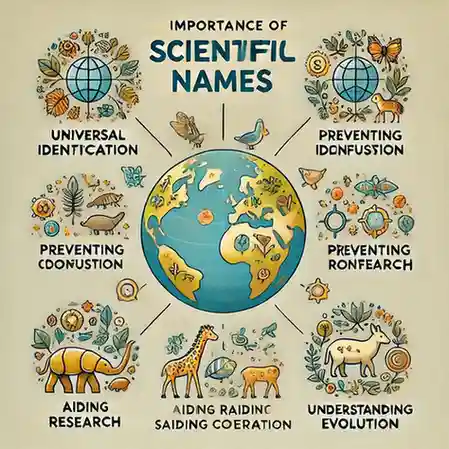Do you ever wonder why some scientific names are more difficult to pronounce than others? Learning how to read scientific names is more than just recognizing big words; it is also learning a global naming convention that links biology, ecological science, and environmental science. Knowing how to read scientific names makes for clear and consistent conversations about living organisms, no matter where you happen.

In this article, we’ll show you how to learn and say these names correctly. This will help you explore the fantastic world of nature. We’ll dive into the details of scientific name pronunciation and give you the tools to read them right.
Table of Contents
The Importance of Scientific Names
Binomial nomenclature is key for scientists. It was introduced in the 1700s by Carl Linnaeus. It makes scientific names clear and easy to use. In modern biology and other fields of science, binomial nomenclature is very important. It is used in a variety of applications.
Who Introduced Binomial Nomenclature?
Carl Linnaeus, Swedish botanist. His creation of binomial nomenclature was an important simplification of naming that had already existed. He standardized all living things with a two-part name.
It consists of a genus name and a specific epithet. With the advent of such a standard, the long and confused names were transformed into real simple, scientific names.
Structure of Scientific Names
A scientific name consists of two parts. They are simple but powerful.
| Component | Description | Example |
|---|---|---|
| Genus | First word, capitalized | Ursus |
| Specific Epithet | The second word, lowercase | americanus |
These two parts make each species unique. For example, Ursus americanus is the American black bear. Names are usually italicized, indicating their Latin roots.
How to Read Scientific Names
Learning to read scientific names is at the core of biology and taxonomy. It is what lets you comprehend organisms better. Knowing Latin or Greek helps since many of these names have roots.
Let’s understand that you can break up the scientific name into parts. Focus on prefixes, suffixes, and roots. This renders the intimidating names much clearer. Also, meanings start to open up, as they typically relate to the organism’s features or habitat.
Practice identifying the scientific names until they become natural to you. It is better to deal with just one name at a time because you can progress more slowly. Not only does it help with recognizing species, but it also puts you on the pathway to comprehension of taxonomy.
| Component | Meaning | Example |
|---|---|---|
| Genus | The first part of the scientific name indicates a group of closely related species. | Homo (as in Homo sapiens) |
| Species | The second part of the scientific name specifies a particular organism within that genus. | sapiens (as in Homo sapiens) |
| Suffixes | Generally indicate associated features, habitats, or origins. | -aceae (family names, as in Rosaceae) |
| Prefixes | Often indicate geographical origin and special features. | Eu- (true, as in Eucalyptus) |
These methods will allow you to read scientific names and with constant practice, sharpen the skill. This opens up a deeper connection with the natural world.
Pronunciation of Scientific Names
Scientists need to know how to say scientific names to communicate clearly. Latin names are generally based on that language, the sounding words being difficult to pronounce, given that this language is not modern. Hence, the same name would pronounced by different people in their respective cultures.

Challenges with Pronunciation
The history of Latin and its current sound is quite different. Hence, the same scientific name can probably be pronounced differently. This can lead to differences in comprehension, especially in discussions and teamwork.
Common Pronunciation Systems
Scientists use various figures of speech while pronouncing scientific names. Some referred to rules laid down before under Latin, some of which have a sound system or, simply, to pronounce phonetically. Here are examples of regular, common methods:
- Classical Latin: It’s very much to the point in the old Latin sense of the word.
- Eclectic Approach: Mix the different ways of speaking with Latin basics.
- Phonetic Systems: It’s simply using sounds to pronounce something as naturally as daily speaking.
Having learned from these methods, you only partially would have helped you say scientific names better. Besides, if you get it wrong, all is well with you so long as somebody understands you.
| Pronunciation System | Description | Pros | Cons |
|---|---|---|---|
| Classical Latin | Follows the original Latin pronunciation rules. | Authenticity and respect for historical context. | Can be difficult for non-specialists. |
| Eclectic Approach | Blends elements from various linguistic traditions. | Flexibility and greater accessibility. | Lack of standardization possible. |
| Phonetic | Emphasizes sound over strict adherence to Latin conventions. | Highly approachable, practical for everyday use. | It may not reflect true historical pronunciation. |
Decoding Scientific Names: The Roots
The roots of scientific names relate to a whole domain of knowledge. Most names derive from Latin or Greek. Every name tells us something specific about a species, like characteristics or behaviors. Knowing the origins will allow us to make guesses about what unknown names might mean.
Latin & Greek Origins
Scientific names usually derive from Latin or Greek. Some names describe what is unique about a species. Knowing these languages helps the understanding and memorization of scientific names.
Commonly Used Roots in Scientific Names
Knowing some common roots provides further insight into the decoding of scientific names. Here are some roots that you will see very often:
By knowing these roots, we can understand scientific names better. This makes the process of learning about them fun and amicable. This gives a scope for outsiders as well as serious students to delve deeper into the world of scientific nomenclature.
| Root | Meaning | Example |
|---|---|---|
| Micro | Small | Microorganism |
| Macro | Large | Macromolecule |
| Ophthalm | Eye | Ophthalmology |
| Phyt | Plant | Phytoplankton |
| Zo | Animal | Zoo |
Importance of Accurate Naming Conventions
Taxonomy organizes and categorizes all living things into their orders, domains, kingdoms, or species. It enables us to understand the diversity of life and how these organisms are related to each other.
Scientific names are clear in identifying organisms. They are essential for research and communication between scientists.
Understanding Taxonomy
Taxonomy systems make it easier for scientists to group organisms according to traits so they can study and identify them. This is a way of viewing how all life is related.
Taxonomy is that, from the smallest microbes to the largest animals and plants, it creates a standard way of naming that every scientist around the world can recognize.
Importance of Accurate Naming Conventions
Getting names right is very important in taxonomy. Following set rules avoids confusion in scientific talks. The International Code of Zoological Nomenclature guides this.
Clear names help scientists work together better. They understand each other’s research on different organisms more easily.
| Taxonomic Rank | Description | Example |
|---|---|---|
| Domain | The highest taxonomic rank groups organisms based on fundamental characteristics. | Eukaryota |
| Kingdom | A rank below domain, categorizing organisms into major groups. | Animalia |
| Phylum | A group of related classes showcasing structural similarities. Chordata | Chordata |
| Class | A rank that further divides phylum into more specific groups. Mammalia | Mammalia |
| Order | A subgroup within a class that reflects additional similarities. | Carnivora |
| Family | A category comprising related genera. | Felidae |
| Genus | A group of species that share common characteristics. | Felis |
| Species | The most specific rank identifies individual organisms. | Felis catus |
Conclusion
It is appropriate for students, researchers, and nature enthusiasts to learn how to read scientific names, as this is a major means of enabling a clear discussion of Earth’s biodiversity. The ability to pronounce scientific names allows individuals to specify species accurately and confidently join in discussions of scientific issues.
This article is a basic treatise on decoding scientific names, covering concepts like binomial nomenclature and taxonomy, which help elucidate how living organisms get their names and classifications. Once people have learned how to read scientific names accurately, they begin to understand some of the complexities of the natural world and how life forms are interrelated.
Devoting attention and time to the exploration and practice of how to say scientific names diplomatically enhances appreciation for the scientific method; this engenders an attitude toward lifelong learning. These newly acquired skills add to personal cognition while promoting communal understanding in communities that hold science, nature, and education dear.

